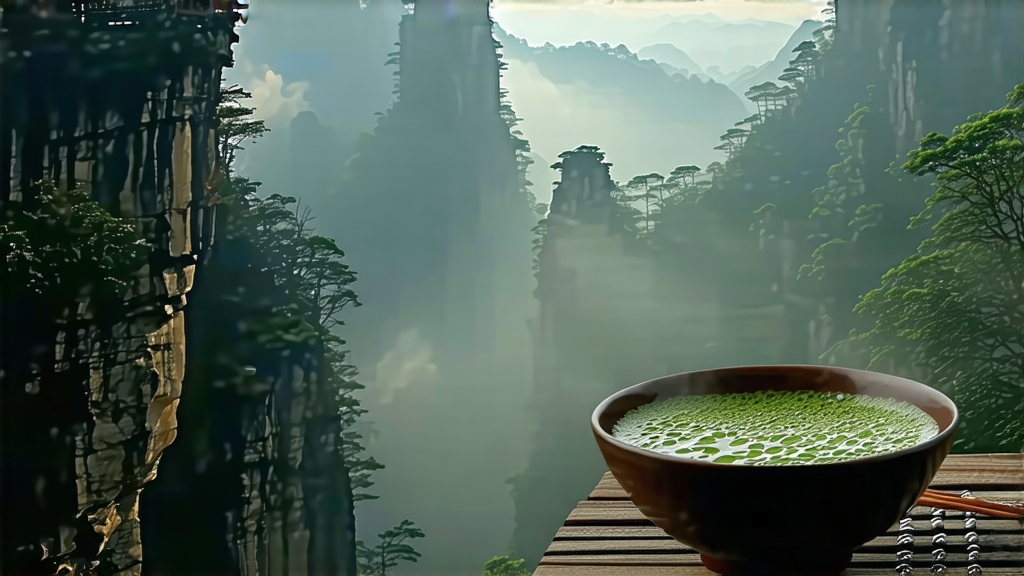
If green tea is the dew of spring and pu-erh the patina of time, then Da Hong Pao—literally “Big Red Robe”—is the basalt heartbeat of the Wuyi Mountains. This rock oolong, born on almost vertical cliff gardens in northern Fujian, carries the scent of mineral, orchid, and ember in one sip. For centuries it was a guarded tribute; today it is the flagship Chinese oolong that connoisseurs chase for its “rock rhyme,” a mouthfeel so stony-lush that locals say it tastes like licking the mountain itself.
Legend fixes the tea’s birth in the early Ming dynasty, when a passing scholar, cured of fever by monks who brewed leaves from six mother bushes, draped his crimson imperial robe over the shrubs in gratitude. The robe’s color became the tea’s name; the bushes, still alive on a 350-meter-high ledge of Jiulongke, are now national monuments protected by cameras and armed guards. Cuttings taken in the 1980s created garden populations throughout the Wuyi scenic zone, so modern drinkers can taste authentic pedigree without plundering the relics.
Botanically, Da Hong Pao belongs to the Wuyi qi zhong (“strange cultivar”) landrace, a mix of seedlings and selected clones such as Bei Dou #1 and Que She. Gardens sit inside a 60-km volcanic canyon where morning mist refracts light, afternoon heat is stored by purple shale, and a constant stream of spring water keeps roots cool. These micro-conditions force the leaves to thicken their cell walls, concentrating minerals and aromatic precursors that later translate into the celebrated yan yun—rock rhyme—a cooling, menthol-like finish that echoes the sensation of wet slate.
Harvest begins in late April when three half-mature leaves and a bud are plucked between 9 a.m. and noon, the moment when surface dew has evaporated but before the sun wilts the leaf. The first transformation is outdoor withering: the leaves are spread on bamboo screens set on cliff-side racks so they sway in canyon drafts, losing 10 % moisture and inhaling the scent of wild orchids and rhododendron. Next comes indoor withering in a cedar loft where charcoal embers beneath the floor maintain 28 °C; here the leaf softens further, preparing for the signature yao qing—“rocking green.”
Yao qing is half dance, half chemistry. Two workers toss 5 kg of leaves into a rattan drum, then roll the drum across the floor for eight minutes, bruising edges without breaking veins. The ruptured cells release catechins that immediately oxidize in mountain air, turning leaf rims reddish-brown while the center stays jade. This partial oxidation—hovering between 30 % and 40 %—is the hallmark of oolong, and in Da Hong Pao it must stop the moment floral notes peak. A sudden 220 °C bake in an electric wok kills the enzymes, locks the bouquet, and sets the stage for the tea’s most romantic act: charcoal roasting.
Traditional roasting lasts three months. The leaves rest in linen sacks hung inside a brick kiln where longan-wood charcoal smolders at 80 °C for four hours, cools for twenty, then repeats at 75 °C, 70 °C, and so on, descending five degrees each cycle. Masters judge readiness by ear: when the crackle inside a handful of leaves sounds like distant pine resin, the tea is finished. The process reduces moisture to 3 %, caramelizes amino acids into cocoa and toasted nut notes, and layers a whisper of smoke that will integrate after six months of “retiring” in unglazed clay jars.
To brew Da Hong Pao well, treat it like a guest from the Song dynasty: offer respect, but do not suffocate. A 120 ml gaiwan or small Yixing teapot, 6 g of leaf, and water just off a cliff-spring boil (95–98 °C) are standard. The first 5-second rinse awakens the compressed charcoal soul; discard it. Subsequent infusions start at 10 seconds, adding 3–5 seconds each round. A seven-step pour—circling the rim then drilling the center—ensures every leaf unfurls evenly. Good leaves yield ten infusions: the first two are mineral shock, like licking wet gravel; middle steeps bloom into narcissus, honey and cream